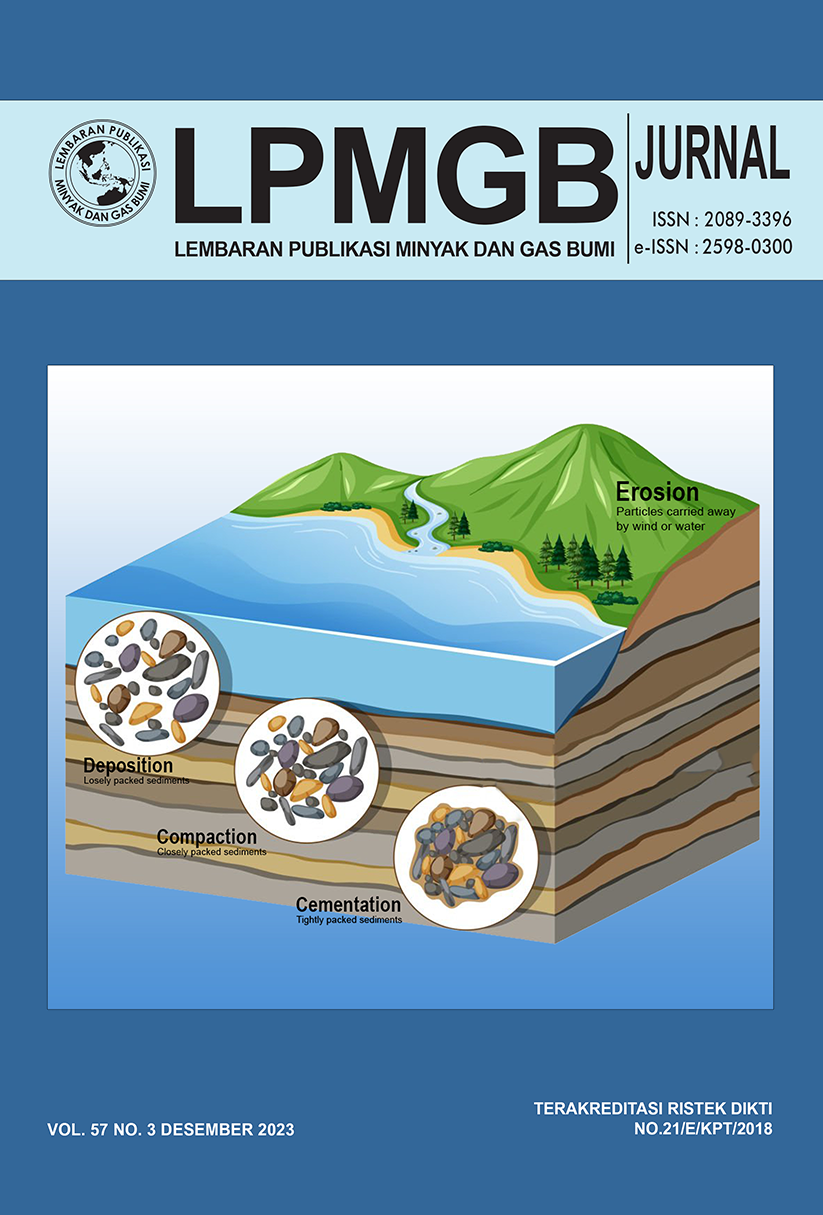Redesain Electric Submersible Pump (Esp) pada Sumur yang Mengandung Gas “W- 30†Lapangan “Aâ€
DOI:
https://doi.org/10.29017/LPMGB.58.1.1610Kata Kunci:
redesain, electric submersible pump, mengandung gas, wiggins, coltharpAbstrak
Sumur “W-30†terpasang pompa dengan tipe P4/60Hz. Pompa ini mempunyai rentang produksi antara 300 blpd–600 blpd, sementara laju produksi aktual adalah 614 blpd. Dari sini sudah terlihat bahwa laju alir berada di atas rentang produksi pompa. Selain itu, berdasarkan grafik Coltharp, persentase upthrust yang terjadi mencapai 63%, yang mana melebihi batas 50%, sehingga perlu adanya redesain. Redesain dimulai dengan pembuatan IPR metode Wiggins karena metode ini cocok untuk sumur dua fasa dan WC yang tinggi. Kemudian, dilakukan sensitivitas frekuensi dan analisis gas bebas pada pompa terpasang untuk memastikan bahwa pompa terpasang sudah teroptimasi. Hasil sensitivitas frekuensi tidak menghasilkan laju alir yang diinginkan, sehingga langkah yang dipilih adalah penggantian pompa melalui sensitivitas frekuensi pada PSD konstan untuk menentukan frekuensi pompa yang akan dipasang, dilanjutkan dengan sensitivitas PSD pada frekuensi konstan untuk menentukan PSD pompa yang akan dipasang. Hasilnya adalah penggantian pompa menjadi tipe P6/60 Hz yang memiliki rentang produksi antara 400 blpd–900 blpd. Persentase downthrust menjadi hanya 12%Referensi
Abdalla, R., Samara, H., Perozo, N., Carvajal, C. P., & Jaeger, P. (2022). Machine Learning Approach for Predictive Maintenance of the Electrical Submersible Pumps (ESPs). ACS Omega, 7(21), 17641–17651. https://doi.org/10.1021/acsomega.1c05881
Ali, A., Si, Q., Wang, B., Yuan, J., Wang, P., Rasool, G., Shokrian, A., Ali, A., & Zaman, M. A. (2022). Comparison of empirical models using experimental results of electrical submersible pump under two-phase flow: Numerical and empirical model validation. Physica Scripta, 97(6), 065209. https://doi.org/10.1088/1402-4896/ac6e96
Gizatullin, F. A., Khakimyanov, M. I., & Shafikov, I. N. (2019). Energy efficiency of well electric submersible pumps for oil production. IOP Conference Series: Materials Science and Engineering, 537(6), 062006. https://doi.org/10.1088/1757-899X/537/6/062006
Iranzi, J., Son, H., Lee, Y., & Wang, J. (2022). A Nodal Analysis Based Monitoring of an Electric Submersible Pump Operation in Multiphase Flow. Applied Sciences, 12(6), 2825. https://doi.org/10.3390/app12062825
Lingom, P. M., Song-Manguelle, J., Betoka-Onyama, S. P., Nyobe-Yome, J. M., & Doumbia, M. L. (2023). A Power Quality Assessment of Electric Submersible Pumps Fed by Variable Frequency Drives under Normal and Failure Modes. Energies, 16(13), 5121. https://doi.org/10.3390/en16135121
Peng, L., Han, G., Sui, X., Pagou, A. L., Zhu, L., & Shu, J. (2021). Predictive Approach to Perform Fault Detection in Electrical Submersible Pump Systems. ACS Omega, 6(12), 8104–8111. https://doi.org/10.1021/acsomega.0c05808
Petrochenkov, A., Ilyushin, P., Mishurinskikh, S., & Kozlov, A. (2023). Development of a Method for Improving the Energy Efficiency of Oil Production with an Electrical Submersible Pump. Inventions, 8(1), 29. https://doi.org/10.3390/inventions8010029
Pham, S. T., Vo, P. S., & Nguyen, D. N. (2021). Effective Electrical Submersible Pump Management Using Machine Learning. Open Journal of Civil Engineering, 11(01), 70–80. https://doi.org/10.4236/ojce.2021.111005
REDA Electric Submersible Pump Systems Technology Catalog. (n.d.).
Rogachev, M., & Aleksandrov, A. (2021). Justification of a comprehensive technology for preventing the formation of asphalt-resin-paraffin deposits during the production of highlyparaffinic oil by electric submersible pumps from multiformation deposits. Journal of Mining Institute, 250, 596–605. https://doi.org/10.31897/PMI.2021.4.13
Shahid, S., Sham Dol, S., Hasan, A. Q., Kassem, O. M., Gadala, M. S., & Aris, M. S. (2021). A Review on Electrical Submersible Pump Head Losses and Methods to Analyze Two-Phase Performance Curve. WSEAS TRANSACTIONS ON FLUID MECHANICS, 16, 14–31. https://doi.org/10.37394/232013.2021.16.3
Shishlyannikov, D., Zverev, V., Ivanchenko, A., & Zvonarev, I. (2021). Increasing the Time between Failures of Electric Submersible Pumps for Oil Production with High Content of Mechanical Impurities. Applied Sciences, 12(1), 64. https://doi.org/10.3390/app12010064
Widiyanto, G., & Syahrial, E. (2022). Optimasi Pompa pada Dewatering Sumur CBM. Lembaran publikasi minyak dan gas bumi, 44(2), 144–153. https://doi.org/10.29017/LPMGB.44.2.160
Yang, P., Chen, J., Zhang, H., & Li, S. (2022). A Fault Identification Method for Electric Submersible Pumps Based on DAE-SVM. Shock and Vibration, 2022, 1–16. https://doi.org/10.1155/2022/5868630
Zhao, Y., Zhao, D., Zhong, Y., & Zhao, Y. (2021). The Viscosity of Oil Influence on the Working Characteristics of Electric Submersible Pump under Variable Speed. IOP Conference Series: Earth and Environmental Science, 661(1), 012023. https://doi.org/10.1088/1755-1315/661/1/012023
Zhou, L., Wang, W., Hang, J., Shi, W., Yan, H., & Zhu, Y. (2020). Numerical Investigation of a High-Speed Electrical Submersible Pump with Different End Clearances. Water, 12(4), 1116. https://doi.org/10.3390/w12041116
Zhu, H., Zhu, J., Rutter, R., & Zhang, H.-Q. (2019). A Numerical Study on Erosion Model Selection and Effect of Pump Type and Sand Characters in Electrical Submersible Pumps by Sandy Flow. Journal of Energy Resources Technology, 141(12), 122004. https://doi.org/10.1115/1.4044941
Unduhan
Diterbitkan
Terbitan
Bagian
Lisensi
Hak Cipta (c) 2024 © Copyright by Authors. Published by LEMIGAS

Artikel ini berlisensiCreative Commons Attribution-ShareAlike 4.0 International License.











